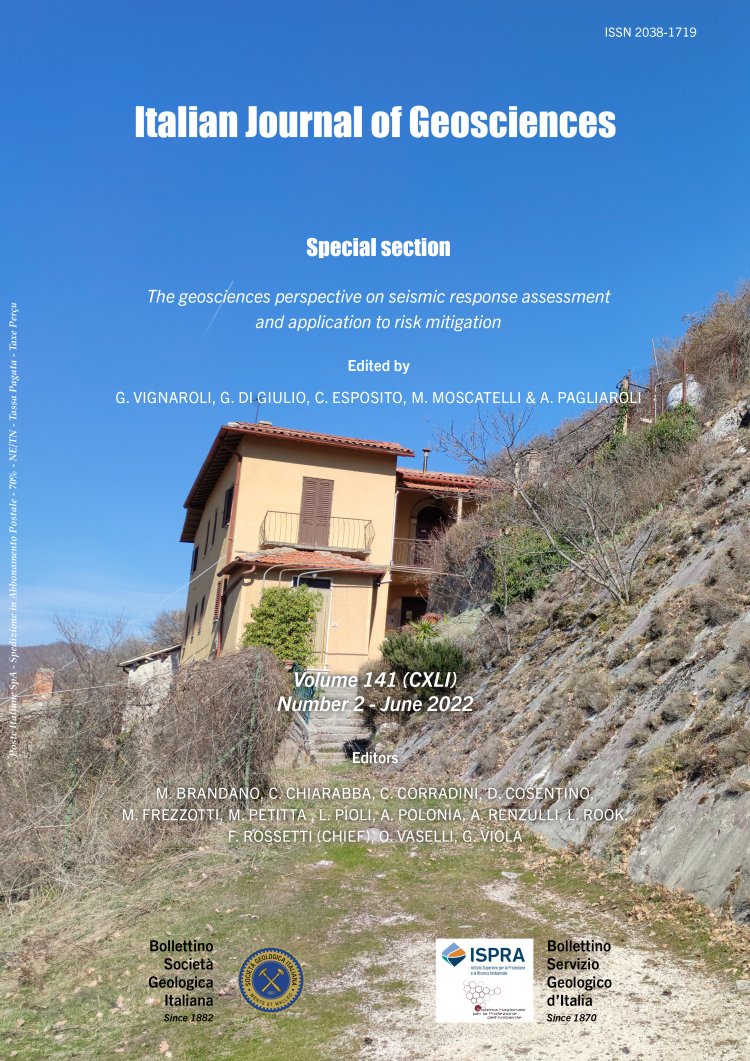
Proposal procedure to evaluate the seismic stability of underground cavities in seismic microzonation studies
Marco Nocentini1,2, Stefania Fabozzi1, Edoardo Peronace1 & Sergio Castenetto3
1CNR-IGAG, Istituto di Geologia Ambientale e Geoingegneria, Area della Ricerca di Roma 1, Via Salaria km 29.300, 00015 Rome, Montelibretti, Italy.
2Now at: Istituto Superiore per la Protezione e la Ricerca Ambientale - ISPRA, Via Vitaliano Brancati, 48, 00144, Roma, Italy.
3Presidenza del Consiglio dei Ministri - Dipartimento della Protezione Civile (DPC), via Vitorchiano 2, 00189 Rome, Italy.
Corresponding author e-mail: marco.nocentini@isprambiente.it
Volume: 141 (2022) f.2
Pages: 184-197
Abstract
Under seismic actions, underground cavities play a not negligible role for seismic site effect and, at the same time, they represent objects exposed to seismic risk. Thus, their possible instability up to the collapse could have effects on the above-ground structures and infrastructures, as revealed by recent and past earthquakes. In consideration of the fact that the presence of underground cavities is very common in many urban and historical areas in Italy, it represents issue of concern for our territory and the related seismic risk should be considered both for planning and management issues.
Being a rather complex topic, the cavity instability under seismic actions is little covered in the technical literature, thus the present work represents a first attempt to frame the problem at different scales. An extensive analysis at national scale was firstly carried out to evaluate the relevance of the problem by using the data stored in the Italian database and catalogue of co-seismic effects and those reported in the database of Seismic Microzonation. This analysis allowed to create a database of Italian co-seismic cavities instabilities, to identify the most susceptible zones in Italy and to preliminarily evaluate some elements of screening. Afterwards, the problem was addressed on an urban scale by proposing a possible procedure to be adopted within the Italian Guidelines for Seismic Microzonation to identify areas potentially prone to seismic cavities collapse.
Currently, the Italian Guidelines for Seismic Microzonation do not address this kind of co-seismic effect by means of specific guidelines as for other instabilities (i.e., liquefactions, landslides, active and capable faults, seismic densification), although underground cavities are regularly reported in the studies. Therefore, the proposed methodology represents a first attempt to define the requirements of Seismic Microzonation studies in areas potentially prone to this kind of co-seismic instability.
According to the SM-Working Group (2008), the proposing procedure defines three levels of zonation, i) attention zones, ii) susceptible zones and iii) respect zones, corresponding to three different cavity seismic instability-prone zones for which, an increasing knowledge levels of the cavity and the geological/geotechnical conditions of the surrounding rocksoil from one hand, and increasing accuracy of the methods adopted to assess the seismic susceptibility of cavity from another, are expected.
The proposed procedure includes for the level 1 of SM a preliminary screening of some predisposing and triggering factors to define the attention zones, while at level 3 of SM the introduction of a simplified approach based on the use of abacuses to preliminary quantify the cavity seismic instability, and an advanced approach to define the respect zones by means of specific numerical analysis.
Keywords
Get Full Text Supplementary Material